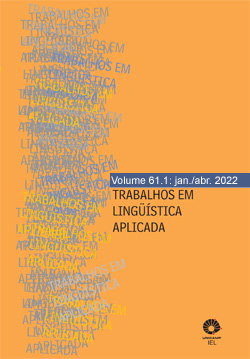Abstract
One of the characteristics of recreational racism is that of stereotyping groups from humor and stereotyped characters. Thus, it becomes possible to project behaviors and values on a minority social group, which would be reduced to a few expected behaviors. For this reason, recreational racism targets non-white people, that is, blacks and, to a lesser extent, Asians and mestizos. The objective of this work is to examine discursive strategies to combat such racism, using one of its main instruments: humor. We wish, therefore, to discuss when a minority group assumes this same discursive procedure in order to reelaborate it through irony, with the intention of resignifying certain social practices linked to this recreational racism. As a corpus, we have elected two videos (“Things that Asians Always Listen to” and “If Asians Always Asked Questions”) from a channel organized on YouTube by a group of young Brazilian artists of Asian descent, entitled Yo Ban Boo. From the dialog of discourse theories (discursive semiotics and discourse analysis), we would like to discuss how stereotypes are constructed in the selected videos, the ways in which Asians are then represented in a little diverse identity, and how humor can be used to reverse the places of power in the interaction between white and non-white. We hope to contribute to a kind of pedagogy that begins the respect for diversity and difference that are attenuated in the constitution of such types of discourses about minority groups.
References
ALMEIDA, S. (2019). Racismo estrutural. São Paulo: Pólen Livros.
AMOSSY, R.; HERSCHBERG-PIERROT, A. (2007). Stéréotypes et clichés. Paris, Armand Colin.
BUENO, A M. (2015). Para uma gramática da intolerância. Entremeios, v. 10, p. 57-68.
BUENO, A. M. Imigrantes japoneses e a língua portuguesa: um caso de preconceito linguístico. (2020). Revista de Estudos da Linguagem, v. 28, p. 455-478.
FIORIN, J. L. (1997). Linguagem e ideologia. São Paulo: Ática.
FONTANILLE, J.; ZILBERBERG, C. (2001). Tensão e significação. São Paulo: Discurso Editorial/Humanitas.
KILOMBA, G. (2019). Memórias da plantação. Rio de Janeiro: Cobogó.
LANDOWSKI, E. (2002). Presenças do outro. São Paulo: Perspectiva.
LANDOWSKI, E. (2014). Interações arriscadas. São Paulo: Estação das Letras e Cores.
MOREIRA, A. (2019). Racismo Recreativo. São Paulo: Pólen Livros.
SANTOS, J. R. dos. (1984). O que é racismo. São Paulo, Editora Brasiliense.
ZILBERBERG, C. (2011). Elementos de semiótica tensiva. São Paulo: Ateliê Editorial.

This work is licensed under a Creative Commons Attribution 4.0 International License.
Copyright (c) 2022 Trabalhos em Linguística Aplicada


